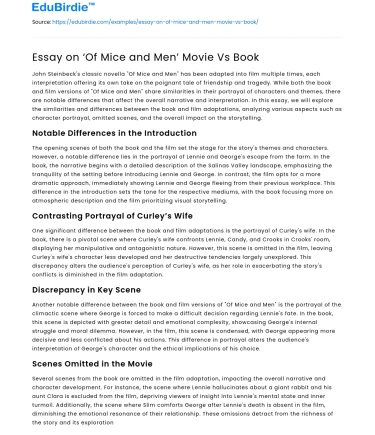John Steinbeck's classic novella "Of Mice and Men" has been adapted into film multiple times, each interpretation offering its own take on the poignant tale of friendship and tragedy. While both the book and film versions of "Of Mice and Men" share similarities in their portrayal of characters and themes, there are notable differences that affect the overall narrative and interpretation. In this essay, we will explore the similarities and differences between the book and film adaptations, analyzing various aspects such as character portrayal, omitted scenes, and the overall impact on the storytelling.
Notable Differences in the Introduction
The opening scenes of both the book and the film set the stage for the story's themes and characters. However, a notable difference lies in the portrayal of Lennie and George's escape from the farm. In the book, the narrative begins with a detailed description of the Salinas Valley landscape, emphasizing the tranquility of the setting before introducing Lennie and George. In contrast, the film opts for a more dramatic approach, immediately showing Lennie and George fleeing from their previous workplace. This difference in the introduction sets the tone for the respective mediums, with the book focusing more on atmospheric description and the film prioritizing visual storytelling.
Save your time!
We can take care of your essay
- Proper editing and formatting
- Free revision, title page, and bibliography
- Flexible prices and money-back guarantee
Contrasting Portrayal of Curley’s Wife
One significant difference between the book and film adaptations is the portrayal of Curley's wife. In the book, there is a pivotal scene where Curley's wife confronts Lennie, Candy, and Crooks in Crooks' room, displaying her manipulative and antagonistic nature. However, this scene is omitted in the film, leaving Curley's wife's character less developed and her destructive tendencies largely unexplored. This discrepancy alters the audience's perception of Curley's wife, as her role in exacerbating the story's conflicts is diminished in the film adaptation.
Discrepancy in Key Scene
Another notable difference between the book and film versions of "Of Mice and Men" is the portrayal of the climactic scene where George is forced to make a difficult decision regarding Lennie's fate. In the book, this scene is depicted with greater detail and emotional complexity, showcasing George's internal struggle and moral dilemma. However, in the film, this scene is condensed, with George appearing more decisive and less conflicted about his actions. This difference in portrayal alters the audience's interpretation of George's character and the ethical implications of his choice.
Scenes Omitted in the Movie
Several scenes from the book are omitted in the film adaptation, impacting the overall narrative and character development. For instance, the scene where Lennie hallucinates about a giant rabbit and his aunt Clara is excluded from the film, depriving viewers of insight into Lennie's mental state and inner turmoil. Additionally, the scene where Slim comforts George after Lennie's death is absent in the film, diminishing the emotional resonance of their relationship. These omissions detract from the richness of the story and its exploration of complex themes.
Personal Opinions on Both Adaptations
In comparing the book and film adaptations of "Of Mice and Men," personal opinions may vary regarding which version is more effective. Some may prefer the depth and nuance of the book, appreciating its detailed characterization and exploration of themes. Others may favor the visual storytelling of the film, finding it more engaging and accessible. Ultimately, both adaptations have their strengths and weaknesses, offering unique interpretations of Steinbeck's timeless tale.
Critique of the Film Adaptation
While the film adaptation of "Of Mice and Men" captures the essence of the story, it is not without its flaws. The pacing of the film may feel rushed at times, with certain scenes glossed over or omitted entirely. Additionally, the removal of key scenes from the book diminishes the impact of the narrative and character development. However, despite these shortcomings, the film remains a faithful adaptation that preserves the spirit of Steinbeck's original work.
The Brilliance of the Story
Regardless of its form, "Of Mice and Men" remains a poignant and thought-provoking exploration of friendship, loneliness, and the human condition. Steinbeck's masterful storytelling and rich characterization ensure that the story resonates with readers and viewers alike, offering timeless insights into the complexities of life and the bonds that unite us. As such, both the book and film adaptations of "Of Mice and Men" stand as testament to the enduring power of storytelling.
Conclusion
In conclusion, while the book and film adaptations of "Of Mice and Men" share similarities in their portrayal of characters and themes, there are notable differences that affect the overall interpretation of the story. From the contrasting portrayals of Curley's wife to the omission of key scenes, each adaptation offers its own perspective on Steinbeck's timeless tale. Ultimately, whether experienced through the pages of a book or on the silver screen, "Of Mice and Men" continues to captivate audiences with its powerful storytelling and profound insights into the human experience.






 Stuck on your essay?
Stuck on your essay?

